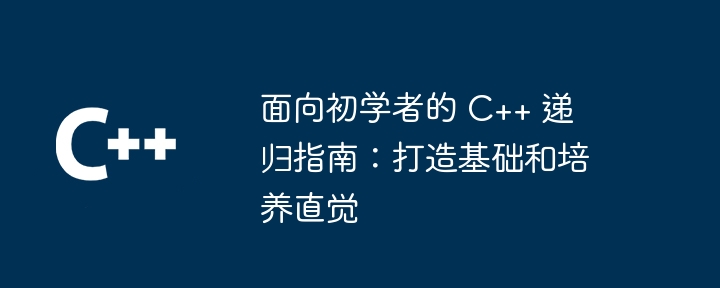Home >Backend Development >C++ >A beginner's guide to C++ recursion: Building foundations and developing intuition
A beginner's guide to C++ recursion: Building foundations and developing intuition
- PHPzOriginal
- 2024-05-01 17:36:021499browse
Recursion is a powerful technique that allows a function to call itself to solve a problem. In C, a recursive function consists of two key elements: the base case (determining when the recursion stops) and the recursive call (breaking the problem into More kid question). By understanding the basics and practicing practical examples such as factorial calculations, Fibonacci sequences, and binary tree traversals, you can build your recursive intuition and use it in your code with confidence.

A Beginner’s Guide to C Recursion: Lay the Foundation, Develop Intuition
Introduction
Recursion is a powerful programming technique that allows functions to call themselves to solve problems. It plays a vital role in many algorithms and data structures and is a valuable tool in any beginner's toolbox. This guide will provide you with the basic knowledge you need to use recursion in C and develop your intuition through practical examples.
Basics
Recursive functions have two key elements:
- Basic situation: Determine when the recursive process stop.
- Recursive call: The step that calls the function itself, which decomposes the problem into smaller sub-problems by reducing the input size.
Practical example
1. Factorial calculation:
int factorial(int n) {
// 基本情况:如果 n 为 0,则阶乘为 1
if (n == 0) {
return 1;
} else {
// 递归调用: 将问题分解为 n-1 的阶乘,并乘以 n
return n * factorial(n - 1);
}
}2. Fibonacci Sequence:
int fibonacci(int n) {
// 基本情况:对于 n = 0 和 n = 1,返回相应的值
if (n == 0) {
return 0;
} else if (n == 1) {
return 1;
} else {
// 递归调用:将问题分解为 n-1 和 n-2 的斐波那契数,并将其相加
return fibonacci(n - 1) + fibonacci(n - 2);
}
}3. Binary tree traversal:
void preorder(Node* root) {
// 基本情况:如果根节点为空,则返回
if (root == nullptr) {
return;
} else {
// 处理根节点
std::cout << root->data << " ";
// 递归调用:对左子树和右子树进行先序遍历
preorder(root->left);
preorder(root->right);
}
}Develop intuition
The best way to establish recursive intuition A good way is to visualize the recursive process. Try drawing a call graph of recursive function calls or imagine the decomposition problem you are working on. The following tips can help you develop your intuition:
- Recognize recursive patterns:Look for functions that can be decomposed into smaller versions of subproblems.
- Understand the basics: Determine when the recursive process stops to avoid infinite loops.
- Step-by-step walkthrough example: Trace the sequence of recursive calls and verify that the problem is decomposed in the expected way.
Conclusion
Recursion is a powerful technique in C that can achieve elegant solutions by decomposing problems. By understanding the basics and practicing real-world examples, you can build your intuition and confidently use recursion in your code.
The above is the detailed content of A beginner's guide to C++ recursion: Building foundations and developing intuition. For more information, please follow other related articles on the PHP Chinese website!

